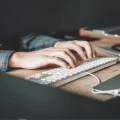Web implementation is the backbone of creating a functional online presence. This involves translating design and functionality requirements into a live website. Effective web implementation ensures that a site is user-friendly, performs efficiently, and fulfills the objectives set by the client. This process and web maintenance services ensure long-term reliability and performance. By focusing on the nuances of web implementation, businesses can deliver engaging user experiences and foster lasting customer relationships. Carefully planned web implementation lays a strong foundation for digital success and continuous growth.
Table of Contents
Importance of Web Implementation
In today’s digital world, a poorly implemented website can hurt a business’s reputation. Lackluster performance, slow load times, and a confusing user interface can drive users away, leading to decreased traffic and conversions. Web implementation influences everything from SEO to the overall user experience, impacting customer satisfaction and conversion rates. A well-implemented site also has easier maintenance and seamless updates, allowing online businesses to stay competitively agile. Consider how SEO practices such as keyword optimization and high-quality content creation directly tie into successful web implementation and boost a site’s visibility and rankings. A seamless implementation ensures that the technical infrastructure of a site supports its content strategy, enhancing both discoverability and usability. In essence, web implementation is the bridge that connects innovative design with functional execution, ensuring a holistic and integrated digital presence.

Key Elements of Successful Web Implementation
Successful web implementation hinges on several core elements:
- User Experience (UX): The website should be intuitive and engaging. This involves clean design, easy navigation, and fast load times. A stellar UX design considers user behavior and preferences, facilitating easy access to information and reducing friction throughout the user’s journey. Investing in UX design can pay dividends by boosting user satisfaction and encouraging repeat visits. Website accessibility is a key component of UX design, as it makes a site increasingly accessible to users with physical and vision-related disabilities. This helps get more prospects and visitors. You can tie up with an expert like “Accessibility Spark” who can help integrate an accessibility App or a WordPress accessibility plugin into your site. It can also help prevent future lawsuits.
- Responsive Design: With the rise of mobile internet usage, ensuring your website is responsive is crucial. This means it should look and perform well on all devices, from desktops to smartphones. A responsive design adapts to different screen sizes and resolutions, providing a consistent and enjoyable experience regardless of the device used. Mobile-first design principles help prioritize content and features most relevant to users on the go, fostering better engagement.
- SEO Best Practices: Good web implementation leverages SEO practices to help the site rank higher in search engine results. This includes proper keyword placement, meta tags, and backlinking strategies. SEO best practices ensure that a website is easily crawlable by search engines and relevant to user queries, ultimately driving organic traffic and improving online visibility. Incorporating SEO from the outset is vital in building a site that looks appealing and performs well in search engine rankings.
- Performance Optimization: A fast, efficient website keeps users engaged and reduces bounce rates. Techniques like image optimization and minifying code significantly enhance site performance. Performance optimization practices, such as reducing server response times and leveraging browser caching, contribute to faster load times and a smoother user experience. Regular performance audits can identify bottlenecks and areas for improvement, ensuring continuous optimization.
Common Challenges and Solutions
Throughout the web implementation process, several challenges may arise. Here are some common issues and their respective solutions:
- Challenge: Cross-Browser Compatibility
- Solution: Conduct extensive testing across multiple browsers to ensure the site performs uniformly. Tools like BrowserStack can aid in this process. Ensuring cross-browser compatibility requires rigorous testing and adjustment to address inconsistencies in how browsers render HTML, CSS, and JavaScript. Thorough cross-browser testing ensures a seamless user experience, irrespective of the browser choice, thereby widening the website’s accessibility.
- Challenge: Mobile Optimization
- Solution: Implement responsive design principles, ensuring the site is mobile-friendly. Testing on various devices helps identify and fix potential issues. Mobile optimization involves creating a flexible and adaptive layout that functions seamlessly across diverse platforms, delivering a consistent user experience. Incorporating touch-friendly navigation and optimizing content for readability on smaller screens are essential steps in mobile optimization. Additionally, using Session Replay Software like Hotjar or FullStory can help identify mobile-specific usability issues by capturing real user interactions. These insights reveal navigation difficulties, slow-loading elements, and friction points, allowing businesses to make data-driven improvements for a smoother user experience and higher conversions.
Staying Ahead with Web Implementation Trends
The field of web implementation is ever-evolving. Staying updated with current trends ensures your website remains relevant and competitive. For example, integrating AI-powered chatbots can improve user interaction and enhance customer service by providing instant responses to queries. Advanced analytics tools provide detailed insights into user behavior, enabling data-driven decision-making to optimize the website continually. Embracing innovations such as voice search optimization and progressive web apps (PWAs) can also provide a competitive edge, enhancing user engagement and satisfaction. Staying ahead of trends helps future-proof your website, ensuring it adapts to changing technologies and user expectations seamlessly.
Tools and Resources for Web Implementation
Utilizing the right tools and resources can streamline the web implementation process significantly. Here are a few essential tools:
- Google Analytics: This tool provides comprehensive data on website traffic, user behavior, and overall performance, helping to make informed decisions. By leveraging Google Analytics, businesses can track key performance indicators (KPIs) and identify areas for improvement. Detailed insights into user behavior, such as bounce rates, session duration, and pages per session, allow for targeted enhancements that drive better user engagement and higher conversion rates.
- SEMrush: A versatile tool, SEMrush assists in SEO analysis, keyword research, and competitive analysis, contributing to better website optimization. Using SEMrush, businesses can uncover valuable insights into their competitors’ strategies and refine their own approach accordingly. The tool’s extensive features help monitor search engine rankings, conduct backlink analysis, and identify opportunities for content optimization, ensuring a competitive edge in the digital landscape.
- Bootstrap: A popular framework, Bootstrap helps create responsive, mobile-first websites quickly and efficiently. Bootstrap’s pre-designed templates and components can accelerate development, ensuring a cohesive and responsive design. The framework’s extensive documentation and community support make it accessible for developers of all skill levels, promoting consistency and scalability in web design projects.
Conclusion
Effective web implementation is crucial for any business looking to succeed online. Companies can create robust websites that attract and retain users by focusing on core elements such as user experience, responsive design, and SEO and staying updated with industry trends and tools. Leveraging proper web maintenance services ensures continued site performance and optimization, securing a strong digital presence in the competitive online space. A well-implemented website is a beacon for online success, driving customer engagement and facilitating business growth. Investing in meticulous web implementation practices and staying adaptable to evolving digital trends ensures a resilient and impactful online presence, setting the stage for sustained success.























